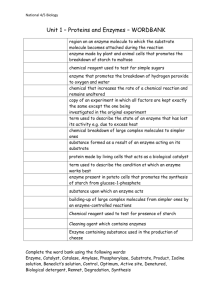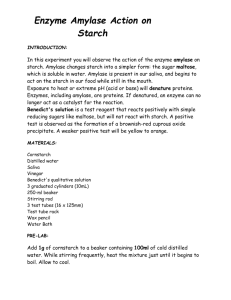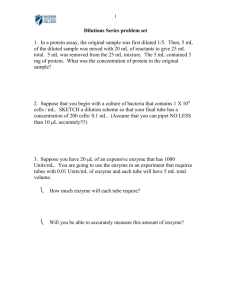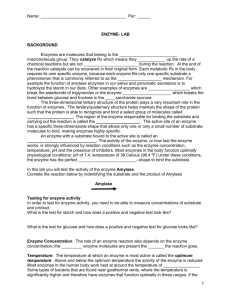Effect of Enzyme Concentration on Enzyme Activity Xochilt Garcia
advertisement
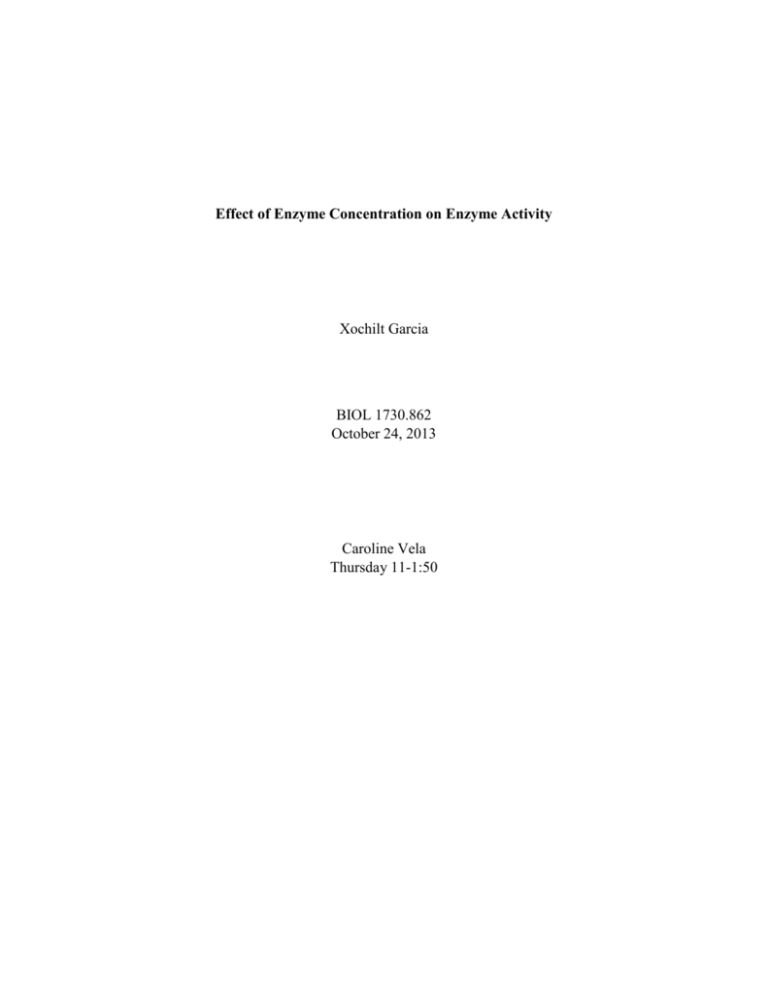
Effect of Enzyme Concentration on Enzyme Activity Xochilt Garcia BIOL 1730.862 October 24, 2013 Caroline Vela Thursday 11-1:50 Abstract This experiment examined the effect of the enzyme concentration on the activity of amylase. To test this, iodine was added to a starch solution in which amylase had been introduced. Starch solution was placed in the wells of two spot plates and a four different concentrations of amylase were introduced. At five minute intervals, iodine was added to determine if the amylase had broken down the starch. The results of this experiment were inconclusive. Introduction The activity of enzymes are affected by three factors: temperature, pH, and enzyme concentration. To test the effect of concentration, amylase is tested to see if it has acted. Iodine is added to a starch solution. If the amylase acted, the solution will stay a light brown as an indicator that it broke the starch down into maltose. If the starch solutions becomes black or blue-black, the enzyme has not acted (Wachtmeister). As the enzyme concentration drops, the enzyme takes longer to act. Materials and Methods Eight test tubes (labeled 1-8) were filled with different solutions according to Table 1. Two porcelain spot plates were arranged and labeled as shown in Table 2. Each of the 24 wells were filled with 5 drops of the starch solution and two drops of the pH 7 buffer. Mix the solution by stirring each well with a toothpick. Then as quickly as possible, one drop of the different amylase concentrations were added consecutively; the undiluted amylase solution was placed in Row A; the enzymes from tube six were placed in Row B; tube 7 in Row C; and tube 8 into row D. For Time 0, one drop of iodine was placed immediately in column 1 and stirred and the results were recorded in Table 3. If the solution was stained black or blue-black, a 1 was recorded. If the solution remained unchanged, a 2 was recorded. At five minute intervals, iodine was introduced and stirred into every well of a column. Table 1: Test Tubes 1-8 and Materials for Each 1 4ml enzyme/amylase 2 3ml pH 7 Buffer 3 3ml distilled water 4 3ml starch 5 3ml iodine 6 1:2 enzyme dilution 4ml 7 1:4 enzyme dilution 4ml 8 1:8 enzyme dilution 4ml Table 1: Test tubes and the materials placed in each tube Table 2: Porcelain Plate Arrangement and Labeling 1 A B 2 3 4 5 6 C D Table 2: The correct positioning and labeling of the porcelain tables and wells. Table 3 Results of Enzyme Concentration Test Enzyme/ Time 0 Time 5 Time 10 Time 15 Time 20 Time 25 Test Tube 1 6 7 8 Table 3: Table for recording observations and results of expirement. Results Amylase did not break down starch and the wells were not stained. Most wells remained unstained. This differs from other groups in that more wells in their experiments were stained by the iodine. As shown in Table 4, the findings seem to be inconsistent and do not follow the expected pattern. Table 4 Results of Enzyme Concentration Test Enzyme/ Time 0 Time 5 Time 10 Time 15 Time 20 Time 25 1 2 2 2 2 2 2 6 1 2 2 2 2 2 7 1 2 1 2 2 2 8 2 1 2 2 2 2 Test Tube Table 4: Results of Enzyme Concentration Test Discussion Due to the inconsistent findings, the hypothesis is rejected. The concentrations did not behave in the way they were expected. There are several possible human errors that occurred that may have skewed the results. During the first trial, solutions were placed in incorrect wells. The porcelain plates were then rinsed but not properly dried. Excess water could have affected the results of this test by slightly altering the enzyme concentrations. Additionally, it is possible too much of any of the materials could have introduced or time wasn’t kept adequately. This experiment does not accurately portray the effects of enzyme concentration on the enzyme activity. References Wachtmeister, H. F. E., & Scott, L. J. (2006). Encounters with life: General biology laboratory manual. (Seventh ed., pp. 44-45). Morton Publishing Company. Aragon, J. J., & Sols, A. (1991). Regulation of enzyme activity in the cell: effect of enzyme concentration. The FASEB Journal, 5(14), 2945-2950.



